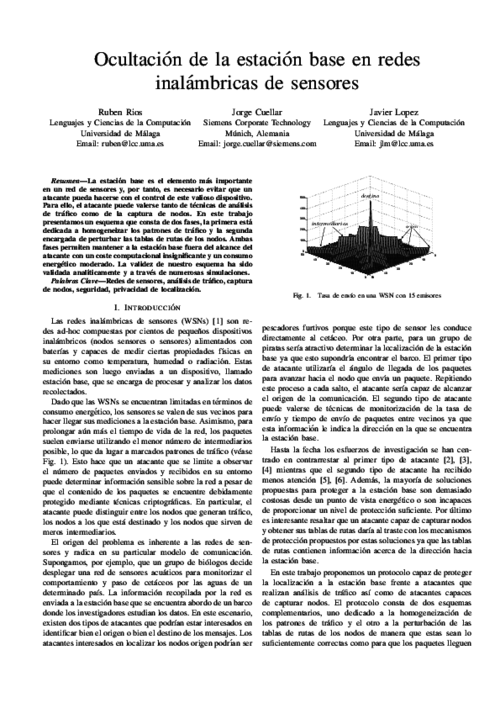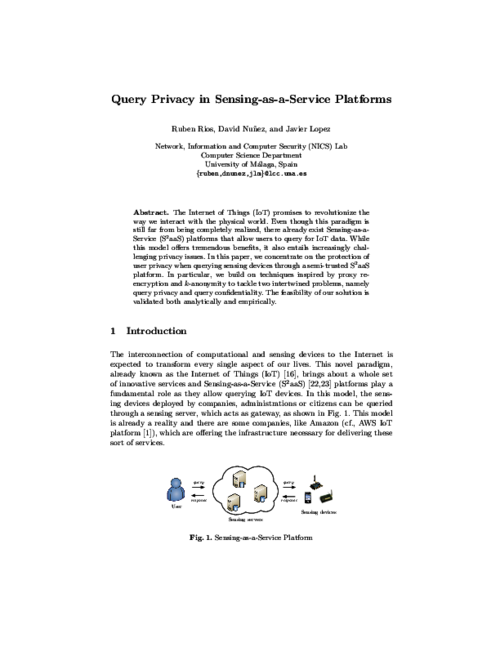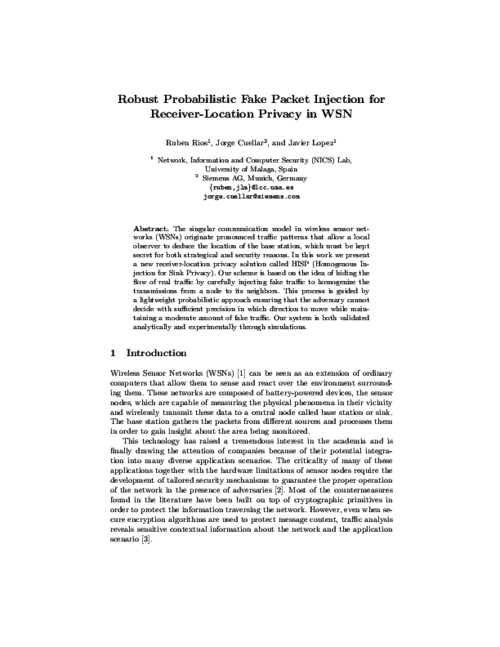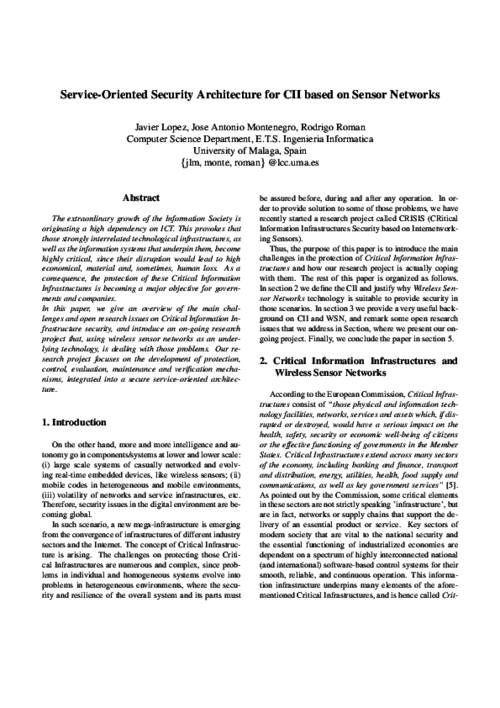 ] Type Year
] Type Year Digital Home Networking, R. Carbou, E. Exposito, R. Roman, and M. Diaz Eds., no. 7130, John Wiley & Sons Inc., pp. 60-96, 2011.
XI Jornadas de Ingeniería Telemática (JITEL 2013), J. E. Díaz Verdejo, J. Navarro Ortiz, and J. J. Ramos Muñoz Eds., Asociación de Telemática, pp. 481-486, Oct 2013.
Abstract
La estación base es el elemento más importante en un red de sensores y, por tanto, es necesario evitar que un atacante pueda hacerse con el control de este valioso dispositivo. Para ello, el atacante puede valerse tanto de técnicas de análisis de tráfico como de la captura de nodos. En este trabajo presentamos un esquema que consta de dos fases, la primera está dedicada a homogeneizar los patrones de tráfico y la segunda encargada de perturbar las tablas de rutas de los nodos. Ambas fases permiten mantener a la estación base fuera del alcance del atacante con un coste computacional insignificante y un consumo energético moderado. La validez de nuestro esquema ha sido validada analíticamente y a través de numerosas simulaciones.

32nd International Conference on ICT Systems Security and Privacy Protection (IFIP SEC 2017), S. De Capitan di Vimercati, and F. Martinelli Eds., IFIP Advances in Information and Communication Technology (AICT) 502, Springer, pp. 141–154, 05/2017. DOI
Abstract
The Internet of Things (IoT) promises to revolutionize the way we interact with the physical world. Even though this paradigm is still far from being completely realized, there already exist Sensing-as-a-Service (S2aaS) platforms that allow users to query for IoT data. While this model offers tremendous benefits, it also entails increasingly challenging privacy issues. In this paper, we concentrate on the protection of user privacy when querying sensing devices through a semi-trusted S2aaS platform. In particular, we build on techniques inspired by proxy re-encryption and k-anonymity to tackle two intertwined problems, namely query privacy and query confidentiality. The feasibility of our solution is validated both analytically and empirically.

17th European Symposium on Research in Computer Security (ESORICS 2012), S. Foresti, M. Yung, and F. Martinelli Eds., LNCS 7459, Springer, pp. 163-180, Sep 2012. DOI
Abstract
The singular communication model in wireless sensor networks (WSNs) originate pronounced traffic patterns that allow a local observer to deduce the location of the base station, which must be kept secret for both strategical and security reasons. In this work we present a new receiver-location privacy solution called HISP (Homogenous Injection for Sink Privacy). Our scheme is based on the idea of hiding the flow of real traffic by carefully injecting fake traffic to homogenize the transmissions from a node to its neighbors. This process is guided by a lightweight probabilistic approach ensuring that the adversary cannot decide with sufficient precision in which direction to move while maintaining a moderate amount of fake traffic. Our system is both validated analytically and experimentally through simulations.

2nd International Workshop on Security Privacy and Trust in Pervasive and Ubiquitous Computing (SecPerU’06), IEEE Press, pp. 1-6, June, 2006.
Abstract
The extraordinary growth of the Information Society is originating a high dependency on ICT. This provokes that those strongly interrelated technological infrastructures, as well as the information systems that underpin them, become highly critical, since their disruption would lead to high economical, material and, sometimes, human loss. As a consequence, the protection of these Critical Information Infrastructures is becoming a major objective for governments and companies. In this paper, we give an overview of the main challenges and open research issues on Critical Information Infrastructure security, and introduce an on-going research project that, using wireless sensor networks as an underlying technology, is dealing with those problems. Our research project focuses on the development of protection, control, evaluation, maintenance and verification mechanisms, integrated into a secure service-oriented architecture.
